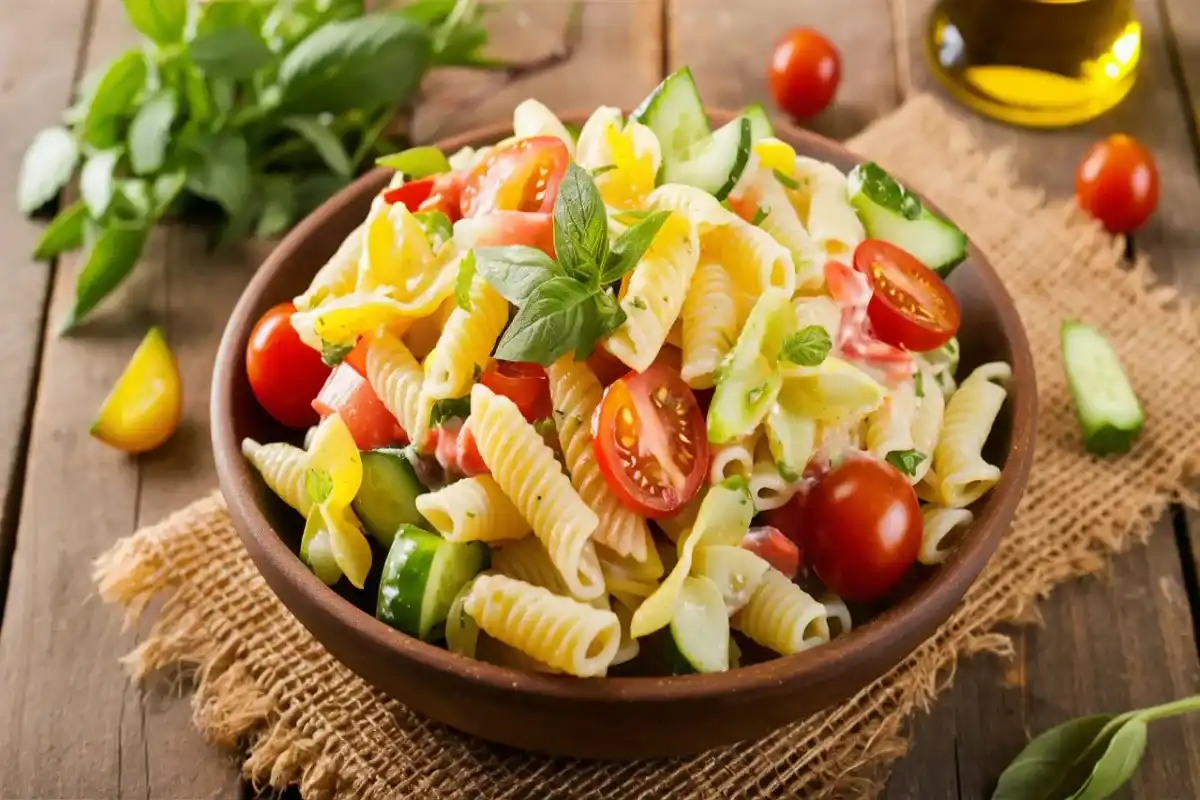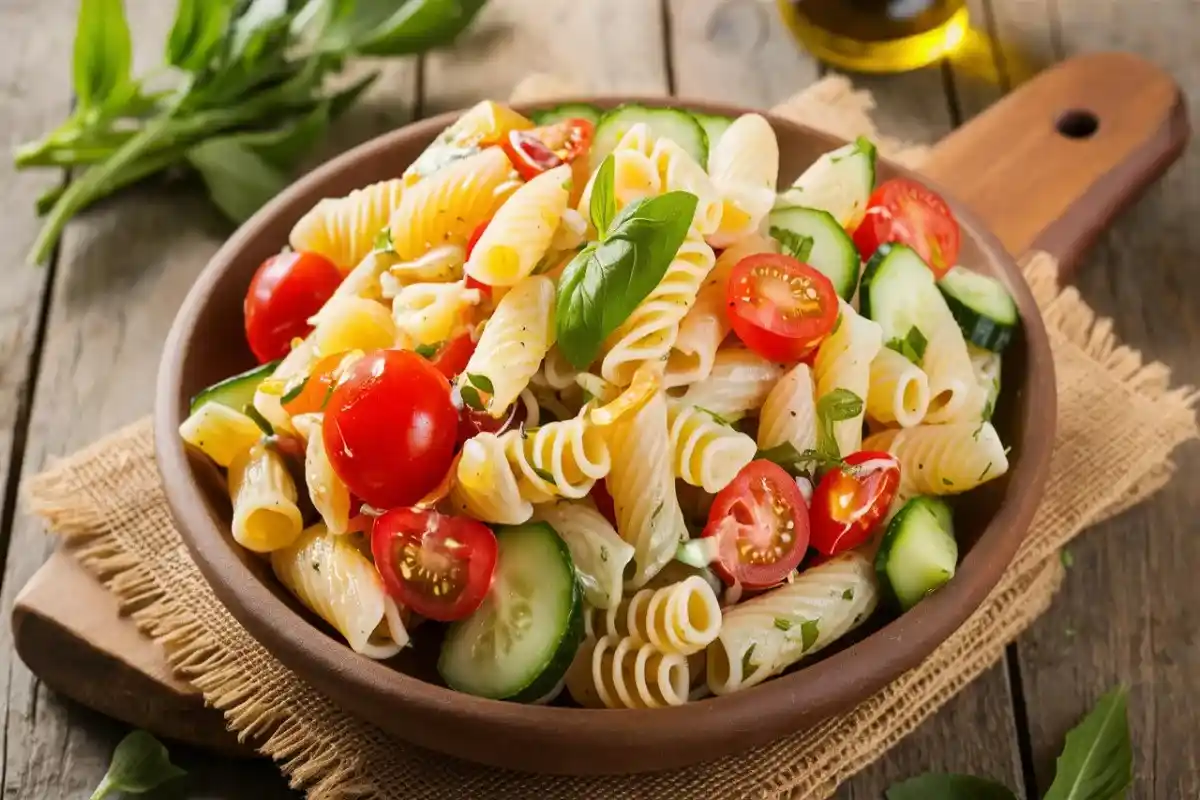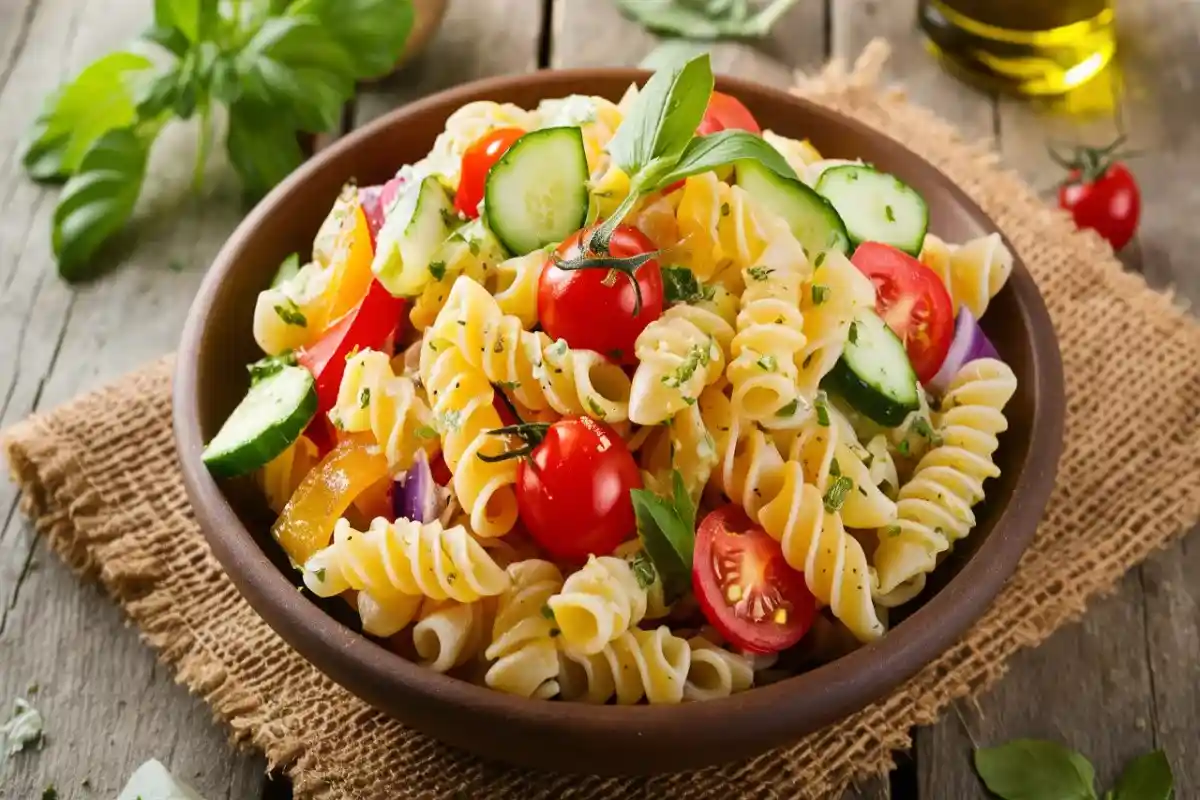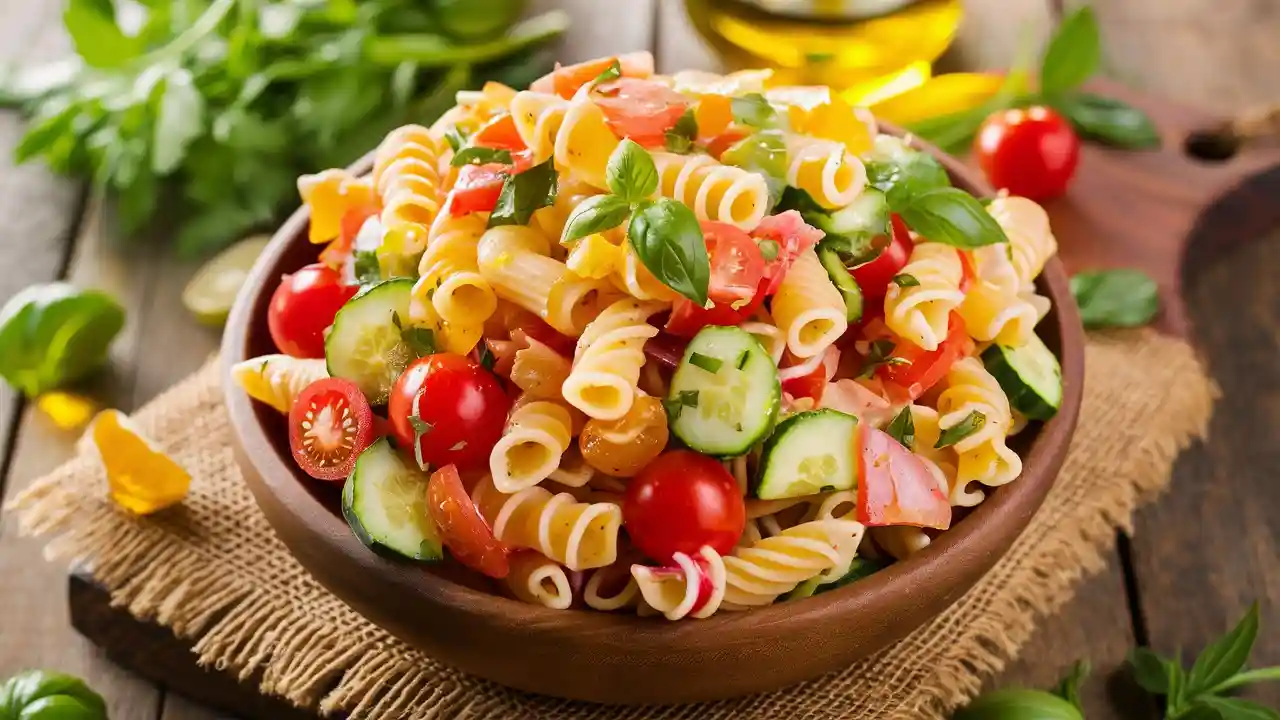Pasta salad is a versatile, crowd-pleasing dish that can be customized in countless ways. Whether you’re preparing a quick lunch, a side dish for a summer barbecue, or a potluck contribution, pasta salad often stands out as a favorite. But as simple as pasta salad might seem, choosing the right type of pasta can make or break the dish. The wrong pasta can lead to a disappointing, mushy, or clumpy salad, which is something no one wants. This brings us to the crucial question: What pasta is not recommended for pasta salads?
In this guide, we’ll explore the types of pasta that are less suitable for pasta salads and explain why. We’ll also provide tips on how to select the best pasta, ways to avoid common pitfalls, and ideas for creating a perfect pasta salad every time.
Why the Type of Pasta Matters in Pasta Salads: Pasta Not Recommended for Pasta Salads
Choosing the right pasta is essential for a delicious pasta salad. Let’s break down why.
Texture
In pasta salad, texture plays a key role. The pasta needs to be firm enough to maintain its shape and not turn mushy when combined with other ingredients and dressing. Overcooked or improperly chosen pasta can result in a salad that is unappetizing and lacks the necessary bite.
Shape
The shape of the pasta is also vital. Different shapes capture and hold onto the dressing and other ingredients in varying ways. Pasta with crevices, ridges, and holes generally works better in pasta salads because they can trap dressing, herbs, and small ingredient pieces. This ensures that each bite is flavorful.
Temperature Considerations for Pasta Not Recommended for Pasta Salads

Pasta salads are typically served cold or at room temperature, which can alter the texture of the pasta. Certain types of pasta do not handle cooling well and may become tough or sticky. Therefore, choosing a pasta type that holds its texture and remains pleasant to eat even when cold is essential.
Absorption of Dressing
Another factor to consider is how well the pasta absorbs and holds the dressing. Some pastas can become overly saturated with dressing, leading to a soggy salad. Others might repel the dressing, resulting in a dry and unevenly flavored dish.
Pasta Types to Avoid in Pasta Salads: Pasta Not Recommended for Pasta Salads
While many types of pasta can work well in pasta salads, some should generally be avoided. Let’s explore which ones and why.
Spaghetti and Other Long, Thin Pastas: Why They Are Pasta Not Recommended for Pasta Salads
Spaghetti, along with other long, thin pasta varieties like linguine and fettuccine, isn’t ideal for pasta salads. The main issue is their shape. Long, thin strands of pasta don’t mix well with other salad ingredients. They tend to clump together, making it difficult for the dressing and other ingredients to coat the pasta evenly.
Additionally, long pasta can be awkward to eat in a cold salad. It often sticks together when cooled and does not hold up well under the weight of heavier ingredients like chopped vegetables, meats, or cheeses. This results in an inconsistent texture and an unbalanced bite, where some portions are overdressed while others are completely dry.
Delicate Pastas (Capellini, Angel Hair)
Delicate pastas like capellini and angel hair are extremely thin and fragile. While they’re excellent for light, brothy dishes, they simply don’t hold up in a pasta salad. These pastas are prone to becoming mushy when mixed with dressing and other ingredients, particularly after refrigeration.
Because of their thinness, these pastas can absorb too much dressing too quickly, leading to a soggy, unappetizing texture. Moreover, the delicate nature of these pastas makes them less able to stand up to chunkier ingredients like olives, tomatoes, or cucumbers.
Stuffed Pastas (Ravioli, Tortellini)
Stuffed pastas like ravioli and tortellini are delicious in hot dishes but aren’t well-suited for pasta salads. The primary issue with using these types of pasta is their filling. When served cold, the texture of the filling can become unappealing—often too firm or dry—and the pasta exterior can become tough or rubbery after refrigeration.
Additionally, the filling can overpower the other ingredients in the salad. With pasta salad, you want each ingredient to contribute to the overall flavor profile. Stuffed pastas can throw this balance off, especially if they contain strong flavors like cheese or meat.
Gluten-Free Pasta (Certain Types)
Not all gluten-free pastas are created equal, especially for pasta salads. Some gluten-free pastas, particularly those made from rice or corn, can become quite mushy when cooked. They also tend to break apart when mixed with dressing and other ingredients. The texture can be gritty or gummy, which is less than ideal for a pasta salad.
Gluten-free pastas that rely heavily on starches can also struggle to hold their structure after being cooked and cooled. This results in a pasta salad that lacks the necessary bite and chewiness. Additionally, these pastas may not absorb dressing as well as wheat-based pastas, leading to a dry salad with poor flavor distribution.
Overly Large Pastas (Jumbo Shells, Lasagna Noodles)
Pasta shapes that are too large, such as jumbo shells, lasagna noodles, or manicotti, are impractical for pasta salads. Their size makes them difficult to mix evenly with other salad ingredients. Additionally, they can dominate the dish, overshadowing the other flavors and textures. Large pasta pieces can be cumbersome to eat in a cold salad format.
Large pastas also create issues with portion control. It’s challenging to serve a balanced portion of pasta salad when the pasta itself is oversized. This can lead to inconsistent bites, where one portion might be all pasta with no accompanying ingredients, while another might have an overload of vegetables or proteins.
Pasta with High Starch Content (Gnocchi)
Pasta varieties with a high starch content, like gnocchi, are typically not suitable for cold pasta salads. Gnocchi, which is often made from potatoes, has a dense, doughy texture that doesn’t fare well when chilled. When cold, gnocchi can become gummy and overly chewy, leading to an unpleasant eating experience.
Additionally, gnocchi tends to absorb a lot of dressing, which can make it soggy and heavy. The dense texture of gnocchi also means it doesn’t mix well with lighter, crisper ingredients that are common in pasta salads.
Best Pasta Options for Pasta Salads (Instead of Pasta Not Recommended for Pasta Salads)

Now that we’ve covered the pasta types to avoid, let’s talk about the best pasta options for pasta salads. These pastas have the right balance of texture, shape, and durability to create a delicious and cohesive salad.
Short, Tubular Pastas (Penne, Rigatoni, Ziti)
Short, tubular pastas like penne, rigatoni, and ziti are excellent choices for pasta salads. Their shape allows them to hold onto the dressing and other ingredients, ensuring that each bite is flavorful. The tubes are also sturdy enough to withstand mixing and don’t clump together as long pastas do.
Twisted and Spiraled Pastas (Rotini, Fusilli, Gemelli)
Twisted and spiraled pastas like rotini, fusilli, and Gemelli are some of the best options for pasta salads. Their intricate shapes provide plenty of surface area to hold onto dressing, herbs, and other ingredients, making every bite flavorful. The nooks and crannies of these pastas also trap small ingredients like chopped vegetables, cheese crumbles, and nuts.
Small Shaped Pastas (Farfalle, Orzo, Small Shells)
Small shaped pastas like farfalle (bow-tie pasta), orzo, and small shells are also great choices for pasta salads. Farfalle has a unique shape that holds up well and adds visual interest to the salad, while orzo, though small, can absorb flavors beautifully without becoming overwhelming. Small shells work similarly to tubular pastas, trapping dressing and small ingredients effectively.
Ridged Pastas (Radiatori, Cavatappi, Campanelle)
Ridged pastas like radiatori, cavatappi, and campanelle are designed to hold onto sauce and dressing, making them fantastic for pasta salads. The ridges catch and hold onto the dressing, ensuring that the pasta doesn’t feel dry. Additionally, these pastas have a substantial bite, which provides a pleasing contrast to softer ingredients.
Tips for Perfect Pasta Salad: Avoiding Pasta Not Recommended for Pasta Salads

Choosing the right pasta is just the first step. Here are additional tips to ensure your pasta salad turns out perfectly every time.
Cook the Pasta Al Dente: A Key to Avoiding Pasta Not Recommended for Pasta Salads
Cooking the pasta al dente (meaning “to the tooth” in Italian) is crucial for pasta salad. This means that the pasta should be cooked until it is firm but not hard, with a slight bite to it. Al dente pasta holds its shape better, especially when mixed with dressing and other ingredients. It doesn’t become mushy even after refrigeration.
Rinse the Pasta After Cooking to Avoid Pasta Not Recommended for Pasta Salads
Unlike in hot pasta dishes, where you typically wouldn’t rinse the pasta, in pasta salads, it’s often recommended to rinse the pasta under cold water after cooking. This stops the cooking process immediately, preventing the pasta from becoming too soft. It also helps to cool the pasta down quickly, making it easier to mix with the other salad ingredients.
Dress the Pasta While It’s Warm to Prevent Using Pasta Not Recommended for Pasta Salads
For better flavor absorption, dress the pasta while it’s still slightly warm. The warmth helps the pasta absorb the dressing more effectively, ensuring that each piece is well-coated. However, avoid adding too much dressing at this stage; save some to add just before serving, as the pasta will absorb more dressing as it sits.
Balance the Ingredients
Ensure a good balance of pasta to other ingredients. Too much pasta can make the salad feel heavy, while too many add-ins can overwhelm the dish. Aim for a balanced ratio, with the pasta making up about half to two-thirds of the salad and the rest composed of vegetables, proteins, cheeses, and other mix-ins.
Add Fresh Herbs and Acid
Fresh herbs like basil, parsley, dill, or cilantro can brighten up the flavors in your pasta salad. Similarly, a splash of acid, such as lemon juice or vinegar, can help balance the richness of the dressing and add a refreshing tang to the dish.
Make It Ahead, but Not Too Far Ahead
Pasta salad is a great make-ahead dish, but it’s best to prepare it no more than a day in advance. If you make it too far ahead, the pasta may absorb too much dressing and become soggy. If you need to prepare it in advance, keep some dressing aside and mix it in just before serving to freshen up the salad.
Season Generously
Pasta salad can often require more seasoning than you might expect. Be sure to taste and adjust the seasoning before serving, adding more salt, pepper, or herbs as needed. A sprinkle of Parmesan cheese or a drizzle of extra virgin olive oil can also enhance the flavors.
Frequently Asked Questions (FAQs)
1. Can I use any type of pasta for pasta salad?
While you can use any type of pasta, some pastas are better suited for pasta salads than others. Long, thin pastas, delicate pastas, stuffed pastas, and certain gluten-free pastas are generally not recommended because they can become clumpy, mushy, or overly delicate. Opt for short, sturdy pastas like rotini, penne, or farfalle for the best results.
2. Why does my pasta salad become dry after refrigeration?
Pasta salad can become dry after refrigeration because the pasta continues to absorb the dressing as it sits. To prevent this, add a little extra dressing before serving to moisten the salad. Additionally, using a pasta that holds onto dressing well, like twisted or ridged shapes, can help keep the salad moist.
3. How can I prevent my pasta from sticking together in the salad?
To prevent the pasta from sticking together, rinse it under cold water after cooking. This removes excess starch that can cause clumping. Also, tossing the pasta with a small amount of dressing immediately after rinsing can help coat the pasta and prevent it from sticking.
4. Can I freeze pasta salad?
Freezing pasta salad is not recommended, as the texture of the pasta can become mushy when thawed. Additionally, ingredients like fresh vegetables, cheese, and certain dressings don’t freeze well. It’s best to prepare pasta salad fresh or store it in the refrigerator for up to 3 days.
5. What’s the best way to store leftover pasta salad?
Store leftover pasta salad in an airtight container in the refrigerator. Before sealing the container, add a little extra dressing on top to help keep the salad moist. Stir well before serving to redistribute the dressing and ingredients. Pasta salad can be stored for up to 3 days.
Conclusion
Selecting the right type of pasta is crucial to creating a delicious pasta salad. By avoiding delicate, overly large, or highly starchy pastas, you can prevent your salad from becoming clumpy, mushy, or unappetizing. Instead, choose sturdy, short, and textured pastas like rotini, penne, or farfalle, which will hold up well under dressing and mix beautifully with other ingredients. With the right pasta and a few simple tips, you can ensure your pasta salad is always a flavorful, visually appealing, and perfectly textured dish that will impress at any gathering.

